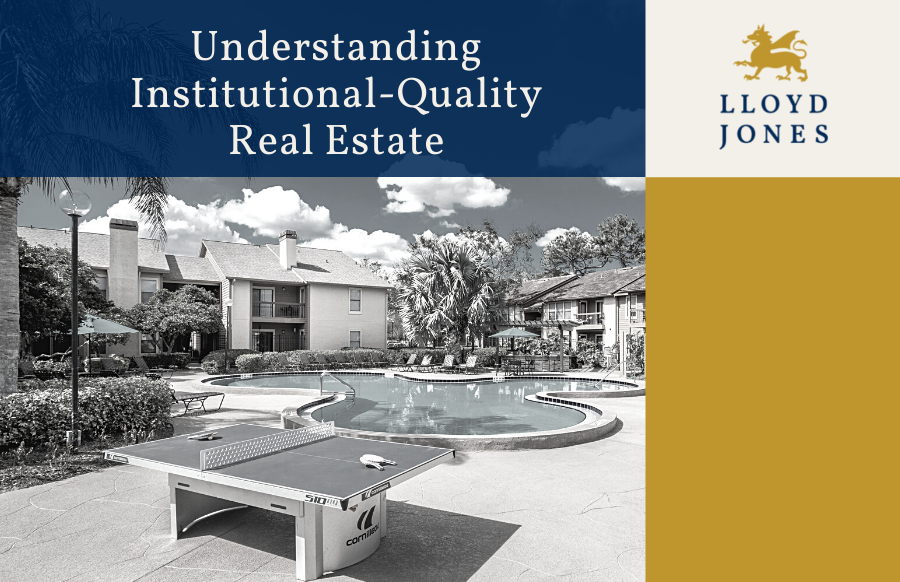Why Is Senior Housing an Opportunistic Investment?
In the world of real estate, investors make every effort and invest lots of capital to accurately predict the course of the market. What type of asset will be desirable? Who are the consumers that will want it? When will the level of demand reach its peak? Where will consumers want these assets? How much will consumers be able to pay for a particular asset type and class?
With real estate asset types like industrial, retail, and multifamily, some variables are often difficult or impossible to accurately predict due to factors that may be peripherally related to the subject market.
With senior housing, many of these variables are partially or entirely negated with simpler predictive qualities; a quick look at some basic demographic and income charts gives the bulk of information needed to make accurate investment decisions. Beyond that, senior housing does not relate to consumers’ wishes as much as it relates to their needs.
These factors make senior housing an exceptionally safe investment choice, so long as the investments are with businesses that intend to deliver forward-looking, innovative care models. Blindly throwing money at just any senior housing investment is not advisable in any way, as dated ideas and buildings that are past their peak will not be attractive to residents.
This chart showcases annualized returns by asset class over a number of years. Pulling data from a very anomalous time in the real estate world, right in the heart of the COVID crisis. However, it’s still possible to see that senior housing is an asset class that, though it may take time, delivers outsized returns compared to other types of real estate.
The key driving force behind the growth of senior housing and our ability to predict with certainty that there is growth is the enormous influx of baby boomers reaching ages requiring senior housing. Baby boomers are that generation of people born post-WWIII between 1946 and 1964 that will, in its entirety, have aged beyond 65 years old by the end of the current decade. The current market lacks the supply to fulfill the future need, and a considerable percentage of locations and demographics have historically been unserved due to their location or economic situation.
The combination of these factors spells opportunity for the senior housing industry, real estate investors, as well as future residents who will have a retirement experience they earlier assumed was only for the extremely well-to-do.
We all know that past performance is no guarantee of future successes, but we can predict with certainty that demand will rise and will rise significantly for senior housing, and we also know that supply is restrained. This provides us with an unusually transparent opportunity to review the factors that will determine a good (or bad) investment and to act accordingly. Here are some of the specific points that make senior housing such an attractive investment.
Related: Why You Should Add Commercial Real Estate To Your Investment Portfolio
Looking to invest your money instead of losing its value sitting in a bank? Check out Lloyd Jones for investment opportunities that will make your money work for you!
Senior Housing Is in High Demand Due to an Aging Population
With the baby-boomer generation aging out of the workforce and into the period in which they will need increased health-care and assisted-housing services, the demand for senior housing communities increases with each passing year.
An investor’s most valuable information in any industry is an advanced notice about the future demand for a product or service. This advanced notice has been available to anyone interested in looking at census data for half a century with the senior housing market.
Baby boomers have been an attention-grabbing generation for the entirety of their existence, and the entry into their golden years is no exception. It is impossible for real estate, healthcare, and many other industries to ignore the fact that the largest single group of retirees will be entering into systems that are simply incapable of handling the sheer numbers coming their way.
While the moment where demand outpaces supply has not quite arrived yet, that moment is not far in the future. The land is not cheap, and construction is not quick, so even in instances where distressed hotels and other existing assets can be renovated and repurposed for use as a senior housing community, the time for investors to act is sooner rather than later.
Capturing Underserved Markets With the Proper Price Point
One of the keys to growth in the senior housing industry is focusing on historically underserved demographics. In the past, there have been millions of middle-income individuals for whom the industry has failed to provide appropriately priced services, aiming above and below them.
The industry has been losing out on this group’s business at the same time that these millions of seniors have missed out on getting the care that would have substantially improved their quality of life.
This large group of seniors in the middle of the economic spectrum were too financially well-off to qualify for subsidized or “affordable” housing. Conversely, they were not well-off enough to afford the more boutique-style senior living facilities, so a large portion of this economic class opted to pay for in-home health aides, remain in their homes for as long as possible, eventually moving anyway to some form of assisted living.
The results have not been positive in either the financial sense or overall health outcomes. According to the CDC, falls result in over $12 billion collectively in out-of-pocket expenses for patients across the nation each year. On top of that, in many cases, the health of these individuals suffers when easily treatable issues go untreated simply due to infrequent medical examinations. Ironically, these individuals who opted to hold off on senior living ended up needing it sooner rather than later due to their choice to avoid it for as long as possible.
This is an instance where the senior housing industry must make simple changes to deliver notable results for investors and to reach this type of resident that the industry has thus far overlooked. The senior housing industry needs to connect with these middle-income seniors, both economically and in terms of messaging. The branding needs to communicate that senior housing has a place for them, it is a good choice for their health, and it is not an overpriced luxury designed for someone other than themselves.
Capture Secondary and Tertiary Markets: Make Residents’ New Home the Same as Their Old Home
One of the significant changes coming is that senior housing will no longer be limited to densely populated urban areas. Rapidly aging baby-boomer populations that made homes in suburbs across the nation will make senior housing both profitable and necessary in those areas.
Even more specifically, for many in this population, the only way they will make the move to senior housing is if it is near the neighborhoods that they have called home for decades, where they have raised their children, where they have established a network of friends, or where their families live.
Interested in exploring the benefits of investing in multi-family development? Lloyd Jones is the one-stop shop you’ll need to learn everything there is on the subject.
Is Senior Housing Recession-Proof?
Unlike economic choices that consumers can delay during a recession like buying a boat, home, or any other product or asset, delaying a move to senior housing is not something that can go on indefinitely. The physical realities of aging grow with time and must be addressed.
Even during the last couple of years when the COVID pandemic resulted in many seniors putting a hold on their plans to move, the market has not been seriously dampened. Despite the most extreme, disruptive force in the history of senior housing, modern economics and growth predictions of recent years are still equally accurate due to the “senior tsunami” that is upon us.
Arguably, these estimates might now appear to be too conservative as many seniors and those soon entering the ages requiring assistance have experienced the challenges of everyday life during COVID without any health issues.
Though dated, the graph below does an excellent job of demonstrating how senior housing rental rates did not respond to the global financial crisis of the 2008 to 2010 period in the same way as other asset classes did.
The senior-housing industry was the one asset class during that black swan event that saw only a very mild reduction in rental rate growth. Utilizing savings, selling their primary residences, turning to insurance, or leveraging offspring income streams among other income sources, residents of senior housing facilities maintained their rental payments even during times of economic downturns. In fact, before entering senior housing facilities, residents often worked with facility owners to establish financial plans to cover the final chapter of their lives.
The trends we saw during the pandemic painted a slightly different picture. While rental rates remained stable relative to other real estate asset classes reinforcing the trends we saw during the global financial crisis of 2008-2010, what we did see was a drop in occupancies. This was driven by regulatory and health concerns to protect residents, restrictions on accepting new residents, and a desire of the elderly to remain in their homes and stay isolated. This trifecta of factors, while causing a decline in occupancy did not impact rental rates for those in place but created a barrier to accepting new residents.
As the impact of the pandemic recedes, that demand is now flooding back. Indeed some senior housing providers are already reporting record move-in rates as residents seek to establish a home where they can be free of the burdens and dangers – physical, financial, and social – of living alone without any assistance.
Related: Understanding Institutional-Quality Real Estate
Senior Housing Has High Crossover With Tech and Healthcare Industries
The potential synergy of senior housing with other industries is almost limitless. Tech, healthcare, and construction are just a few areas in which innovations can and will change the nature of senior housing and the outcome it provides both residents and investors.
Some innovation is sure to be extraordinary, and here at Lloyd Jones, we are at the forefront of researching and implementing systems that enhance resident quality of life, reduce costs, and improve even further our levels of care.
Discovering New Applications for Existing Tech in Healthcare
The simplest of these technologies is video chatting, implemented (and quite successfully rebranded as telehealth) to benefit patients, facilities, doctors, medical staff, pharmacists, transportation specialists, and everyone else involved in the process of providing patient treatment.
Until the rise of telehealth, there were no options other than scheduling elderly patients for regular checkups and then telling them to come in when unusual symptoms emerged. With telehealth, doctors are now able to determine which instances require patients to come in for an office visit, which warrant a hospital trip, and which require nothing more than thorough monitoring of vitals and symptoms.
The amount of time, paperwork, money, and stress this has saved is almost incalculable. As the use of telehealth appointments increases, senior housing will provide superior health outcomes at lower costs when compared to seniors remaining in their homes.
New Health Tech, Better Patient Outcome, More Profitable Senior Housing
Remote patient monitoring is an example of technology that is now being implemented in various healthcare spaces and will certainly take root in numerous points of the senior housing continuum of care. Patients will be able to register various vital signs that will be automatically shared with doctors and health systems to identify common or targeted health concerns before more substantial and costly treatment is necessary.
The capacity and scope of remote patient monitoring is certain to grow and is an excellent example of an area in which forward-thinking senior housing communities will invest to provide better healthcare outcomes while they cut costs.
Related: How Social Connections Keep Seniors Happy, Healthy, and Living Longer
Why Senior Housing Is an Excellent Investment
The growing and unavoidable need for senior housing, the recession resistance of this asset type, and the opportunities to implement both new and existing technologies to improve profitability and health outcomes make senior housing among the best real estate investments currently available.
As with any investment, not only real estate, it is vital to remain at the forefront of trends and developments. Here at Lloyd Jones, we are capitalizing on these trends by acquiring and upgrading facilities to deliver the level of service that will soon become the gold standard for the industry.
As post-pandemic demand returns to senior housing, we are identifying opportunistic acquisitions that capture all the benefits of investing in this industry – at substantially discounted pricing. With a vision for improved care, a superior quality of life, and outsized returns for investors, we are convinced that now is a great time to capitalize on the growing demand for this asset class.


